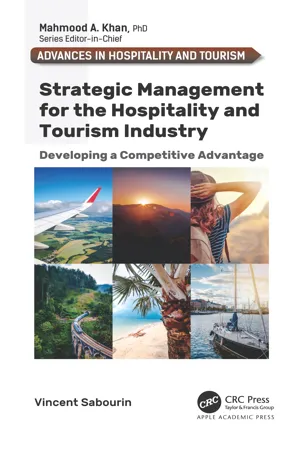
Strategic Management for the Hospitality and Tourism Industry
Developing a Competitive Advantage
Vincent Sabourin
- 192 pages
- English
- ePUB (mobile friendly)
- Available on iOS & Android
Strategic Management for the Hospitality and Tourism Industry
Developing a Competitive Advantage
Vincent Sabourin
About This Book
Thisvital volume clearly explains cutting-edge theories and views on strategic management in applied management fundamentals in the hospitality and tourism industry. The author discusses the latest in strategic thinking and provides information on implementing models within specific contexts, such as culture and profit and nonprofit organizations. He also looks at the political, economic, social, and technological changes that significantly affect tourism and hospitality. The volume is distinguished by its thoughtful analysis and review of related hospitality case studies and the management approaches employed and sheds light on ever-the emerging management and operation issues in the tourism and hospitality sector.
The book employs an abundance of case studies that illustrate the concepts and models discussed, with examples from such heavyweights in the industry as Disney and Euro Disney, Aer Lingus, British Airways, Four Seasons, Holiday Inn, Marriot, Sofitel, Starwood Hotels, and more. Key features of the book include:
- Cutting-edge approach: Applies advanced and recent strategic management views to the tourism and hospitality field.
- Critical treatment: Provides critical discussions about whether and how strategic models/theories can be applied in the hospitality and tourism field.
- Sensitive to specific contexts: As the tourism and hospitality industry has become one of the largest industries worldwide, discusses how strategic management concepts can be applied in different cultures and profit and nonprofit tourism organizations.
- Extensive case studies: Provides supporting case studies related to the strategy content, context, and process from international industries such as Aer Lingus, Accor, Marriott and Ryanair.
- Organization of the book: Each of the chapters within the case study sections employs a thorough pedagogic structure consisting of a concise introduction, examples and case analysis, discussion points, exercises, and further reading.
This book is designed to provoke thought and debate about strategic management and myriad other issues. It will be valuable for students, academics, universities offering hospitality and tourism, and hospitality and tourism professionals.
Frequently asked questions
Information
CHAPTER 1STRATEGIC CONCEPTS AND PERSPECTIVES IN THE HOSPITALITY AND TOURISM INDUSTRY
ABSTRACT
1.1 INTRODUCTION
1.2 THE TRADITIONAL PERSPECTIVE OF STRATEGIC MANAGEMENT
1.3 DEFINITION OF STRATEGY
- Strategy is the creation of a unique and valuable position involving a different set of activities.
- Strategy is making trade-offs in competing.
- And finally, strategy is creating fit among a company’s activities.
1.4 WHY IS “STRATEGY” RELEVANT FOR THE MANAGEMENT?
- Strategy acts as a decision support analysis. Having a quality decision-making process is possible if a proper strategy is put in place. Thus, the strategy improves the quality of decision-making.
- Strategy acts as a communication and coordination tool. Without proper channels of connection within an organization, some ineffectiveness and inefficiency are bound to ensue. Thus, strategy creates consistency and unity among business functions.
- Strategy also acts as an organizational set of targets. There are measures for a consistent performance. In that regard, strategy improves performance by setting high aspirations within the organization.
1.5 IS STRATEGIC MANAGEMENT USEFUL IN THE HOSPITALITY AND TOURISM INDUSTRY?
- Decision-making: Strategic management improves decision processes in the hospitality and the tourism industry but does not necessarily give answers. Though strategic analysis is useful in the decision-making process, managers should conduct independent analysis on the applicability of the formulated decisions. Strategic analysis requires critical thinking and assessment supported by facts.
- Strategic analysis: Strategic management assists the company to identify and understand the main issues in the hospitality and tourism industry. Without identifying and understanding the main issues, an organization may allocate it resources in the wrong products or markets.
- Management of complexity: Strategic management supports the company to manage complexity in the hospitality and the tourism industry. Management complexities tend to arise with the diversification of the number of products, markets, but mainly geographic locations. With proper strategic analysis, managers are able to underscore areas that deserve attention.
1.6 LEVELS OF STRATEGY
1.6.1 CORPORATE STRATEGY, BUSINESS STRATEGY, AND FUNCTIONAL STRATEGY
1.6.2THE PERSPECTIVES FROM THE SCHOOL OF POSITIONING VERSUS THE SCHOOL OF RESOURCES
- For which market do we have growth?
- For which markets do we have weak competition?
- Could we enter quickly with an acquisition?
- What are our unique and distinct skills (lower cost, higher perceived value of our products)?
- How could we leverage resources such as plants and equipments, skills, competencies, and skills, and also culture, structure, and staff profile to develop competitive advantage?
- How could we stretch out internal development to build our competence and develop a competitive strategy?